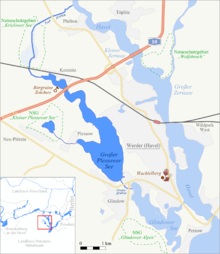geo.wikisort.org - Mountains
The Werderaner Wachtelberg is a 6.2 hectares (15 acres) vineyard in the town of Werder (Havel) in Brandenburg. As the northernmost outpost of the Saale-Unstrut wine region, it is the most northern registered location for QbA quality wine in Germany.[1]



Location, climate and soil
The Wachtelberg (German for "quail's mountain") is located on a 60 m high hill east of the River Havel shaped in the last ice age. The ridge is a remnant of a terminal moraine, formed in the Weichselian glaciation of the last glacial period.
There is a temperate climate on the Werderaner Wachtelberg, affected by the Atlantic climate from the north and west and a continental climate from the east. Weather extremes are not commonplace. The temperature profile around Werder is similar to the national average for Germany. Seasonal temperature fluctuations are smaller than the usual continental climate, but higher than in the balanced maritime climate of coastal regions. Precipitation is, with an annual sum of 519 mm, also relatively small. The area is surrounded by the Schwielowsee, Großer Zernsee and the Glindow-See, and due to its positioning between these vast lakes, a slightly higher than German-average temperature is often measured.
The peculiarity of the vineyard is that the vines grow in slightly argillaceous sand soil. This sandy soil produces mild wines with low acidity. In 1991, the vineyard was affiliated as a single vineyard site ("großlagenfreie Einzellage") by the wine growing region of Saale-Unstrut and thus recognized by the EU. The Wachtelberg is now a classified German vineyard and can be found under the registration 11.1.5.-017[1] in the vineyard register (Weinbergrolle). All Werderaner wines are pressed and vinificated at the Landesweingut Kloster Pforta in Saxony-Anhalt.
Viticulture introduction to the Margraviate of Brandenburg
The introduction of viticulture in the Margraviate of Brandenburg was part of the German eastward expansion, which was started in 1125 by King Lothair III. As a result of this policy, Albert the Bear established his rule in Brandenburg some 25 years later. Historical studies have shown that a wine culture was introduced to Brandenburg from the West.[2] This introduction is part of a west-east spread of viticulture in the Middle Ages in connection with the extension of Frankish and German domination and the spread of Christianity in Europe.[3] During the whole period of the Middle Ages, the Roman Catholic Church and its monasteries were sponsors of the wine culture in the margraviate. The church promoted wineries because wine was used for Holy Communion. In addition to the Franks and the Flemish settlers, it was the Cistercians who played a decisive role in viticulture around the Havel at the time. This must be regarded as the origins for the vineyard in Werder.
References
- Fröhlich, Roland (2001). Am Polarkreis des Weinbaus, der Werderaner Wachtelberg (in German). Potsdam: Vacat Verlag. ISBN 3-930752-17-4.
Footnotes
- Fröhlich, p. 69.
- Fröhlich, p. 26.
- Fröhlich, p. 12.
See also
- German wine
- List of German wine regions
External links
На других языках
[de] Werderaner Wachtelberg
Der Werderaner Wachtelberg ist eine 6,5 Hektar große Weinlage im Stadtgebiet von Werder/Havel im Land Brandenburg. Sie gehört zum Bereich[1] Mansfelder Seen im Anbaugebiet Saale-Unstrut. Sie ist eine der nördlichsten eingetragenen Lagen[2] für Qualitätsweinanbau (QbA) in der Bundesrepublik Deutschland.- [en] Werderaner Wachtelberg
Другой контент может иметь иную лицензию. Перед использованием материалов сайта WikiSort.org внимательно изучите правила лицензирования конкретных элементов наполнения сайта.
WikiSort.org - проект по пересортировке и дополнению контента Википедии